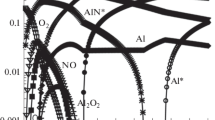Abstract
A consistent physicomathematical model that describes ignition and detonation combustion of a gas suspension of coal-dust particles is developed. The model is based on the concepts of the two-velocity two-temperature continuum of mechanics of heterogeneous media with allowance for reduced reactions of pyrolysis, combustion of volatiles, and combustion of the coke residue. The model is verified with the use of available experimental data on the dependence of the detonation velocity on the initial concentration of the discrete phase and the dependence of the ignition delay on the Mach number of the incident shock wave. An analysis of ignition of the gas suspension of bituminous coal in shock waves shows that the stage of ignition proceeds under conditions of both temperature and velocity nonequilibrium. The influence of particle heating due to stagnation temperature on devolatilization dynamics and ignition delay is established. Examples of computed flow structures behind shock and detonation waves with allowance for the ignition stage are presented.
Similar content being viewed by others
REFERENCES
M. A. Nettleton and R. Stirling, “Detonation in suspensions of coal dust in oxygen,” Combust. Flame, 21, 307–314 (1973).
D. H. Edwards, P. J. Fearnley, and M. A. Nettleton, “Detonation limits of clouds of coal dust in mixtures of oxygen and nitrogen,” Combust. Expl. Shock Waves, 23, No. 2, 239–245 (1987).
A. V. Fedorov and T. A. Khmel’, “Mathematical simulation of detonation processes in a coal-particle suspension,” Combust. Expl. Shock Waves, 38, No. 6, 700–708 (2002).
A. A. Borisov, B. E. Gel’fand, S. A. Tsyganov, et al., “Ignition of dusts behind shock waves,” Khim. Fiz., No. 8, 1127–1128 (1983).
M. Sichel, S. M. Baek, C. W. Kauffman, et al., “The shock wave ignition of dusts,” AIAA J., 23, 1375–1380 (1985).
V. M. Boiko, A. N. Papyrin, and S. V. Poplavskii, “Effect of volatiles on ignition delay of coal dust gas suspensions within shock waves,” Fiz. Goreniya Vzryva, 27, No. 2, 101–111 (1991).
V. M. Boiko, A. N. Papyrin, and S. V. Poplavskii, “Mechanism of dust ignition in incident shock waves,” Combust. Expl. Shock Waves, 29, No. 3, 389–394 (1993).
Yu. A. Gosteev and A. V. Fedorov, “Mathematical simulation of lifting and ignition of particles of coal deposits,” Combust. Expl. Shock Waves, 39, No. 2, 177–184 (2003).
V. A. Levin and Yu. V. Tunik, “Combustion of coal dust in oxygen with an admixture of a gaseous fuel,” Dokl. Akad. Nauk SSSR, 276, No. 4, 834–839 (1984).
L. D. Smoot, M. D. Horton, and G. A. Williams, “Propagation of laminar pulverized coal-air flames,” in: Proc. 16th Int. Symp. on Combustion, The Combustion Inst., Pittsburgh (1977), pp. 375–387.
V. V. Koren’kov and V. N. Okhitin, “Numerical determination of effect of explosive density on parameters of air shock waves,”J. Appl. Mech. Tech. Phys., 24, No. 3, 403–406 (1983).
V. M. Boiko, V. P. Kiselev, S. P. Kiselev, et al., “Interaction of a shock wave with a cloud of particles,” Combust. Expl. Shock Waves, 32, No. 2, 191–203 (1996).
S. A. Zhdan and E. S. Prokhorov, “Detonation of a mixture of RDX particles partially filling a cylindrical channel,” Combust. Expl. Shock Waves, 35, No. 4, 418–421 (1999).
S. K. Ubhayakar, D. B. Stickler, C. W. Von Rosenberg (Jr.), and R. E. Gannon, “Rapid devolatilization of pulverized coal in hot combustion gases,” in: Proc. 16th Symp. (Int.) on Combustion, The Combustion Inst., Pittsburgh (1977), pp. 427–436.
T. W. Lester, W. R. Seeker, and J. F. Merklin, “The influence of oxygen and total pressure on the surface oxidation rate of bituminous coal,” in: Proc. 18th Int. Symp. on Combustion, The Combustion Inst., Pittsburgh (1981), pp. 1257–1265.
I. W. Smith, “The combustion rates of coal chars: A review,” in: Proc. Nineteenth Symp. (Int.) on Combustion, The Combustion Inst., Pittsburgh (1982), pp. 11045–1065.
P. A. Libby and T. A. Blake, “Theoretical study of burning carbon particles,” Combust. Flame, 36, 139–169 (1979).
A. V. Fedorov and T. A. Khmel’, “Mathematical modeling of detonation of an aluminum dust in oxygen with allowance for velocity nonequilibrium of the particles,” Combust. Expl. Shock Waves, 33, No. 6, 688–694 (1997).
Yu. A. Gosteev and A. V. Fedorov, “Ignition of the gas-coal dust mixture. Pointwise approximation,” Combust. Expl. Shock Waves, 37, No. 6, 646–654 (2001).
Author information
Authors and Affiliations
Additional information
Translated from Fizika Goreniya i Vzryva, Vol. 41, No. 1, pp. 89–99, January–February, 2005.
Rights and permissions
About this article
Cite this article
Fedorov, A.V., Khmel’, T.A. Mathematical simulation of heterogeneous detonation of coal dust in oxygen with allowance for the ignition stage. Combust Explos Shock Waves 41, 78–87 (2005). https://doi.org/10.1007/s10573-005-0009-z
Received:
Issue Date:
DOI: https://doi.org/10.1007/s10573-005-0009-z




